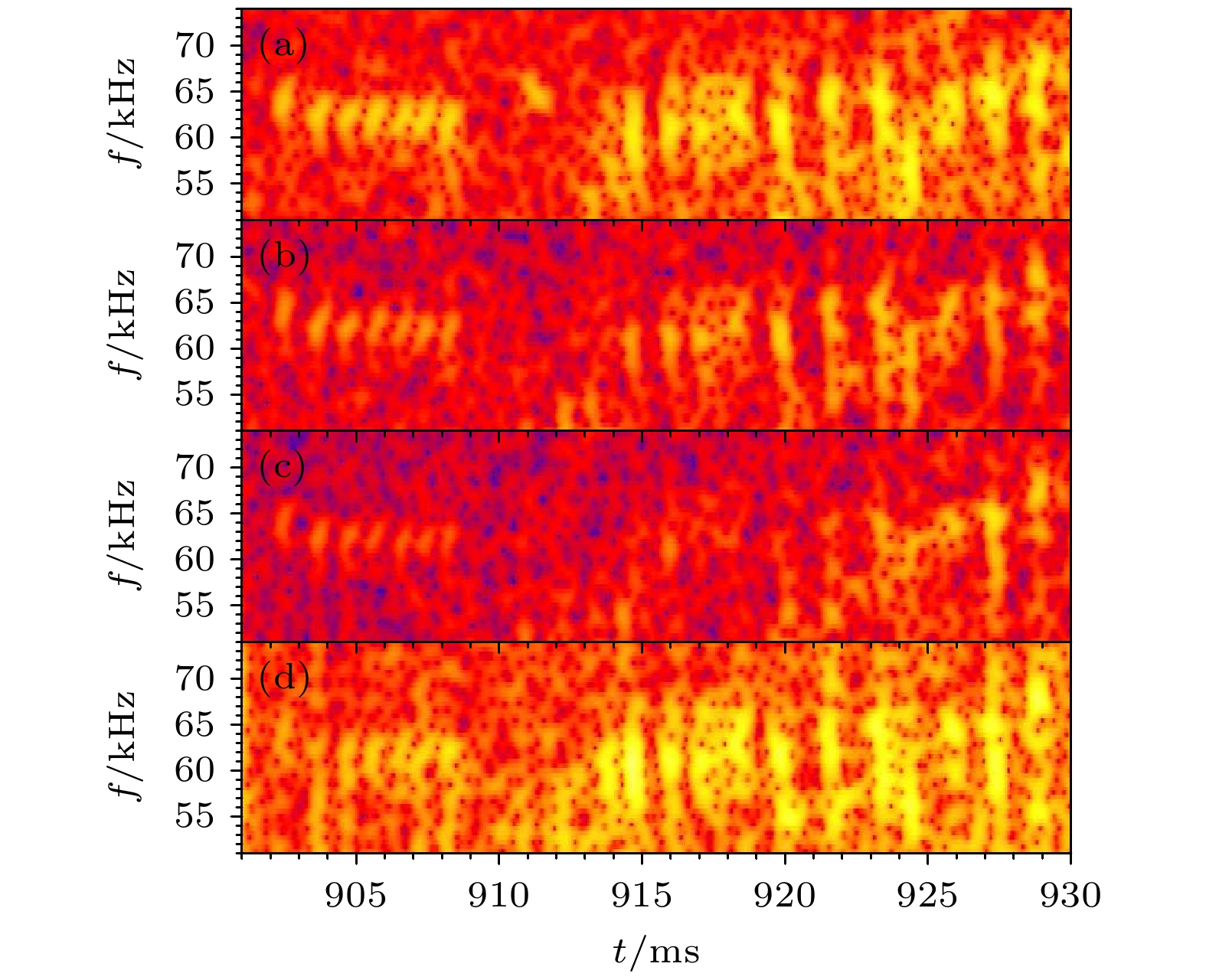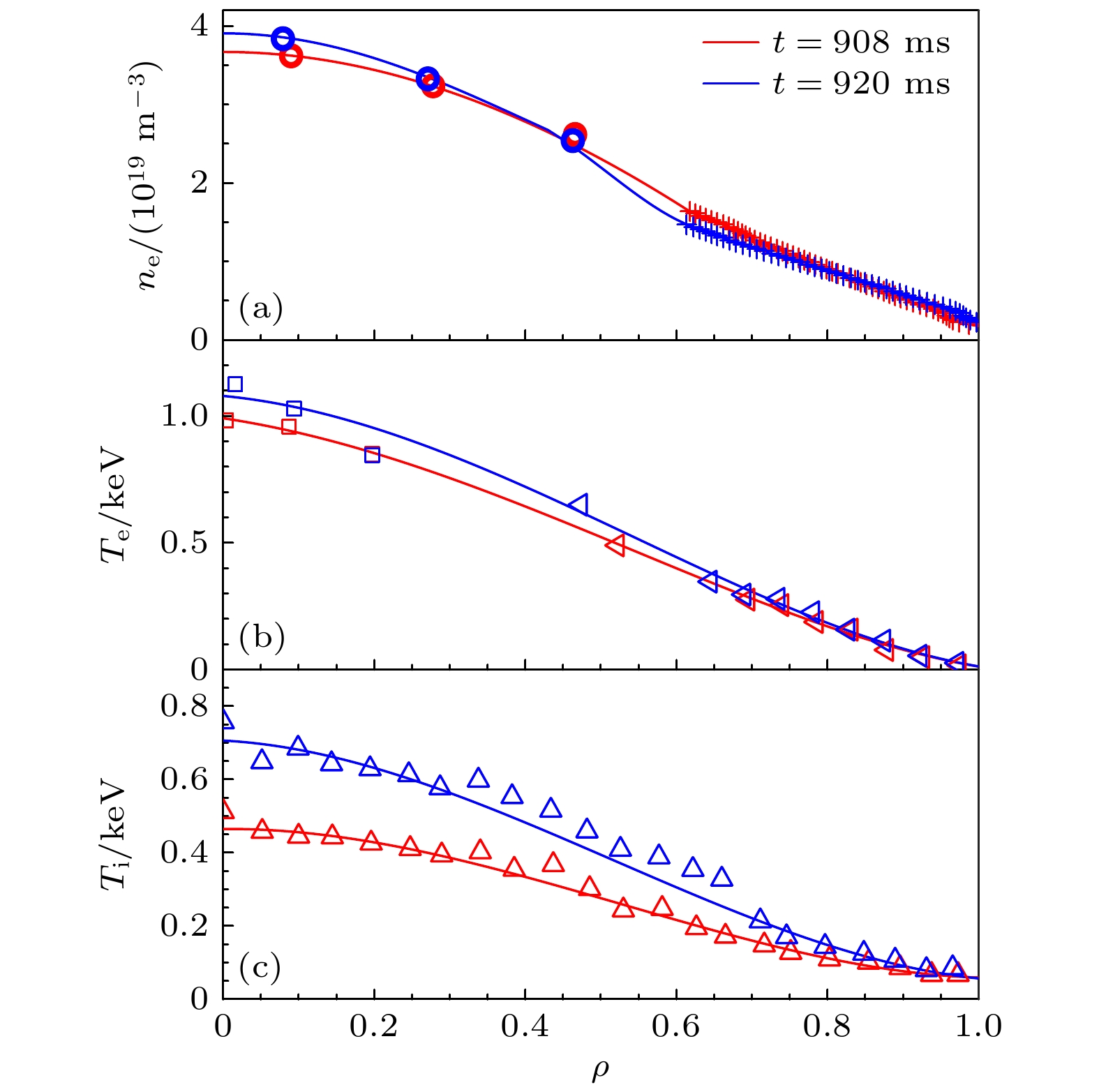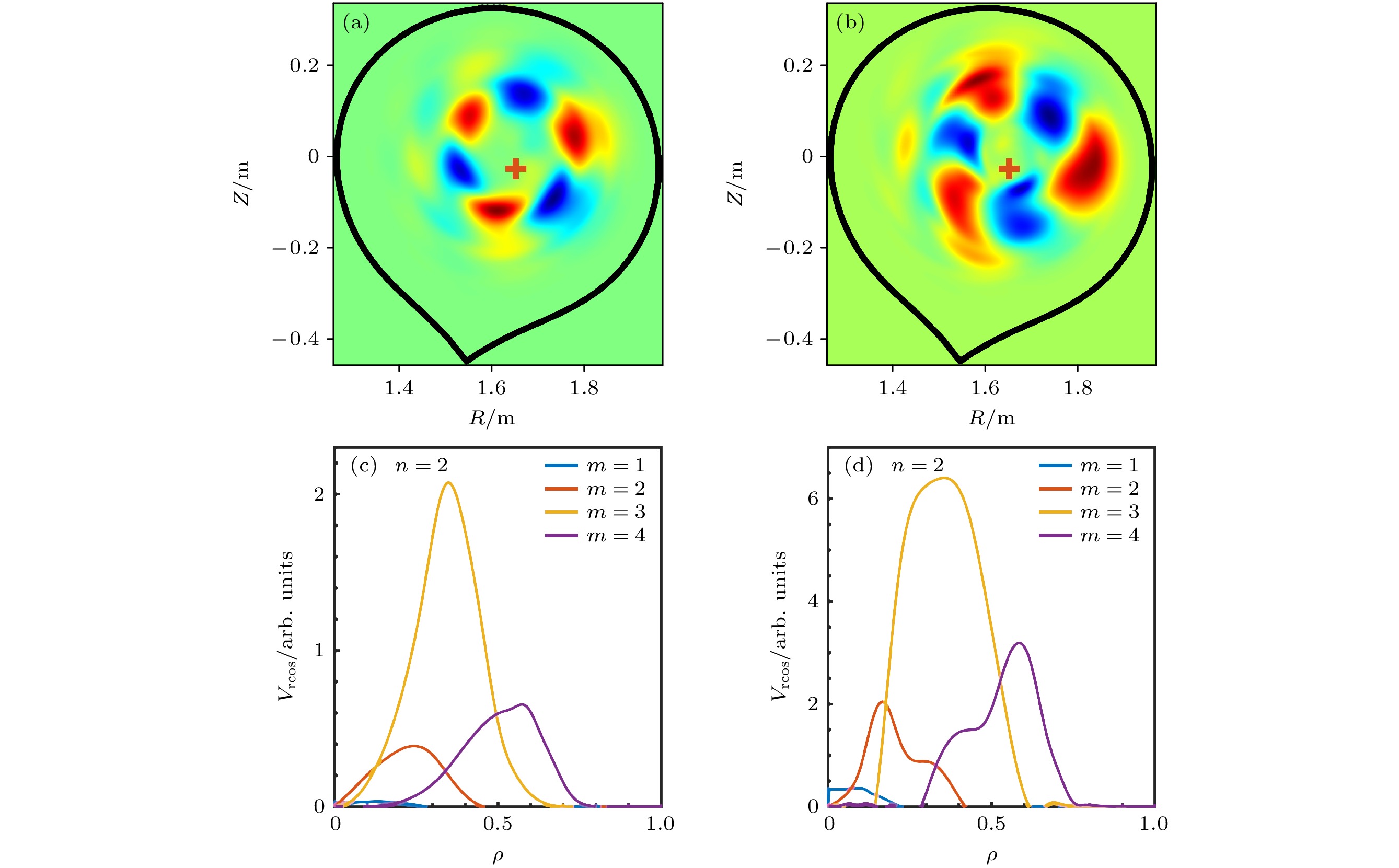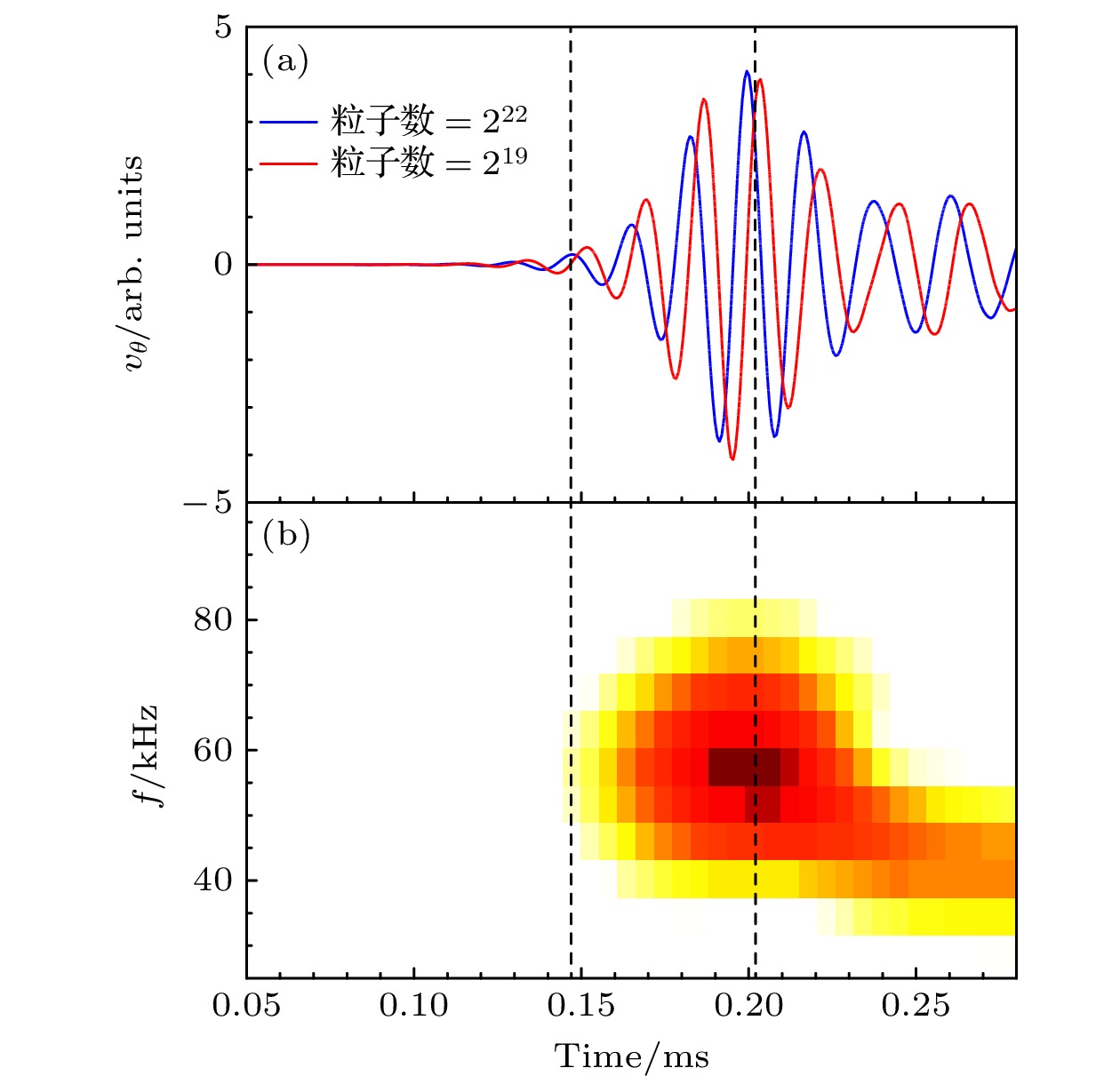-
利用混合磁流体-动理学模拟程序MEGA对中国环流器二号装置观测到的具有频率啁啾行为的比压阿尔芬本征模进行分析. 区别于动理论方法Berk-Breizman模型, MEGA程序采用真实的实验参数, 如平衡位形、电子密度、电子温度和离子温度等, 再现了具有向上和向下扫频特性的比压阿尔芬本征模. 实验观测到下扫频行为出现时背景等离子体的参数和比压值相对更高. 据此设置MEGA程序的输入参数: 在下扫频行为模拟中, 高能量离子的螺矩角初始分布宽度和芯部比压值, 以及扩散系数均更高. 模拟结果显示快离子相空间的分布影响了扫频行为. 当上扫频行为占主导时, 平行于磁场的离子发挥主要作用; 而下扫频行为占主导时, 垂直于磁场的离子密度显著上升. 实验与模拟均表明: 下扫频行为占主导的比压阿尔芬本征模激发对比压值和高能量离子的密度要求更高, 这与之前的模拟分析得到的结论一致.The beta-induced Alfvén eigenmodes (BAEs) with frequency chirping, observed in the HL-2A Tokamak, are analysed by a MHD-kinetic hybrid code MEGA. Realistic parameters are applied to the code, such as equilibrium, electron density and temperature, ion temperature, which is different from the kinetic Berk-Breizman theory. The BAEs are observed by Mirnov probes and soft X-ray arrays. Toroidal and porloidal mode number are confirmed to be n/m = 2/3 by using the phase shift method with toroidal filtered Mirnov signal arrays. And the soft X-ray arrays’ signal shows that BAEs are located at the core of the plasma and they have a relatively broad mode structure. The BAEs with up- and down-chirping are reproduced with MEGA code. The simulation results of mode structure accord well with experimental observations. Compared with up-chirping BAEs, the down-chirping BAEs are excited with higher plasma parameters and beta value, thus the energetic ion distribution in pitch angle has a broader width, and the beta value of energetic ions in the core of plasma and diffusion value are higher in the down-chirping simulation. The simulation results show that the phase space distribution of energetic ions affects the wave chirping direction. The energetic ions parallel to the magnetic field drive the up-chirping behavior. When the down-chirping behavior dominates, the density of energetic ions perpendicular to the magnetic field increases significantly. It shows that the down-chirping BAEs require higher beta and energetic ion density, which is consistent with the previous simulation result.
-
Keywords:
- MEGA code /
- beta-induced Alfvén eigenmodes /
- frequency chirping
[1] Chen L, Zonca F 2016 Rev. Mod. Phys. 88 015008
 Google Scholar
Google Scholar
[2] Wong K L 1999 Plasma Phys. Control. Fusion 41 R1
 Google Scholar
Google Scholar
[3] Heidbrink W W, Strait E J, Doyle E, et al. 1991 Nucl. Fusion 31 1635
 Google Scholar
Google Scholar
[4] Podestà M, Bell R E, Crocker N A, et al. 2011 Nucl. Fusion 51 063035
 Google Scholar
Google Scholar
[5] Wang X, Zonca F, Chen L 2010 Plasma Phys. Control. Fusion 52 115005
 Google Scholar
Google Scholar
[6] Qi L Y, Dong J Q, Bierwage A, et al. 2013 Phys. Plasmas 20 032505
 Google Scholar
Google Scholar
[7] Heidbrink W W, Strait E J, Chu M S, et al. 1993 Phys. Rev. Lett. 71 855
 Google Scholar
Google Scholar
[8] Chen W, Ding X T, Yang Q W, et al. 2010 Phys. Rev. Lett. 105 185004
 Google Scholar
Google Scholar
[9] Ding X T, Chen W 2018 Plasma Sci. Technol. 20 094008
 Google Scholar
Google Scholar
[10] Yu L M, Chen W, Shi Z B, et al. 2021 Nucl. Fusion 61 026019
 Google Scholar
Google Scholar
[11] Shi P W, Chen W, Shi Z B, et al. 2019 Nucl. Fusion 59 066015
 Google Scholar
Google Scholar
[12] Xu M, Zhou T, Xu L Q, et al. 2018 Nucl. Fusion 58 124004
 Google Scholar
Google Scholar
[13] Heidbrink W W 1995 Plasma Phys. Control. Fusion 37 937
 Google Scholar
Google Scholar
[14] Shinohara K, Kusama Y, Takechi M, et al. 2001 Nucl. Fusion 41 603
 Google Scholar
Google Scholar
[15] Pinches S D, Berk H L, Gryaznevich M P, et al. 2004 Plasma Phys. Control. Fusion 46 S47
 Google Scholar
Google Scholar
[16] Fredrickson E D, Gorelenkov N N, Bell R E, et al. 2006 Nucl. Fusion 46 S926
 Google Scholar
Google Scholar
[17] Classen I G J, Lauber Ph, Curran D, et al. 2011 Plasma Phys. Control. Fusion 53 124018
 Google Scholar
Google Scholar
[18] Gryaznevich M P, Sharapov S E 2006 Nucl. Fusion 46 S942
 Google Scholar
Google Scholar
[19] Chen W, Yu L M, Liu Y, et al. 2014 Nucl. Fusion 54 104002
 Google Scholar
Google Scholar
[20] Berk H L, Breizman B N, Pekker M 1996 Phys. Rev. Lett. 76 1256
 Google Scholar
Google Scholar
[21] Berk H L, Breizman B N, Petviashvili N V 1997 Phys. Lett. A 234 213
 Google Scholar
Google Scholar
[22] Lilley M K, Breizman B N, Sharapov S E 2009 Phys. Rev. Lett. 102 195003
 Google Scholar
Google Scholar
[23] Lesur M, Idomura Y, Shinohara K, et al. 2010 Phys. Plasmas 17 122311
 Google Scholar
Google Scholar
[24] Zhang H S, Lin Z H, Holod I 2012 Phys. Rev. Lett. 109 025001
 Google Scholar
Google Scholar
[25] Zhu J, Ma Z W, Fu G Y 2014 Nucl. Fusion 54 123020
 Google Scholar
Google Scholar
[26] Wang X, Briguglio S, Chen L, et al. 2012 Phys. Rev. E 86 045401
 Google Scholar
Google Scholar
[27] Todo Y 2006 Phys. Plasmas 13 082503
 Google Scholar
Google Scholar
[28] Hou Y M, Chen W, Yu Y, et al. 2018 Nucl. Fusion 58 096028
 Google Scholar
Google Scholar
[29] Hou Y M, Chen W, Yu L M, et al. 2021 Chin. Phys. Lett. 38 045202
 Google Scholar
Google Scholar
[30] Wang X Q, Wang H, Todo Y, et al. 2021 Plasma Phys. Control. Fusion 63 015004
 Google Scholar
Google Scholar
[31] Bierwage A, Shinohara K, Todo Y, et al. 2017 Nucl. Fusion 57 016036
 Google Scholar
Google Scholar
[32] Shi Z B, Jiang M, Huang X L, et al. 2014 Rev. Sci. Instrum. 85 023510
 Google Scholar
Google Scholar
[33] Liu C H, Wang Y Q, Feng Z, et al. 2015 JINST 10 C12026
 Google Scholar
Google Scholar
[34] Li Y G, Zhou Y, Li Y, et al. 2017 Rev. Sci. Instrum. 88 083508
 Google Scholar
Google Scholar
[35] Yang Z C, Jiang M, Shi Z B, et al. 2021 JINST 16 P05020
 Google Scholar
Google Scholar
[36] Wei Y L, Yu D L, Liu L, et al. 2014 Rev. Sci. Instrum. 85 103503
 Google Scholar
Google Scholar
[37] Chen W, Ding X T, Liu Y, et al. 2010 Nucl. Fusion 50 084008
 Google Scholar
Google Scholar
[38] Yu L M, Chen W, Ji X Q, et al. 2021 Chin. Phy. Lett. 38 055202
 Google Scholar
Google Scholar
[39] Shi P W, Chen W, Shi Z B, et al. 2017 Phys. Plasmas 24 042509
 Google Scholar
Google Scholar
[40] Pei Y B, Xiang N, Hu Y J, et al. 2017 Phys. Plasmas 24 032507
 Google Scholar
Google Scholar
[41] Hou Y M, Zhou H Y, Chen W, et al. 2023 Rev. Sci. Instrum. 94 033508
 Google Scholar
Google Scholar
-
图 2 利用软X射线阵列信号得到的频谱图 (a) SX51, r = 2.5 cm,
$ \rho \sim 0.065$ ; (b) SX49, r=–7.3 cm,$ \rho \sim -0.1825$ ; (c) SX53, r = 12 cm,$ \rho\sim $ 0.3; (d) SX54, r = 16.3 cm,$ \rho\sim $ 0.4075Fig. 2. Frequency spectrogram obtained with soft X-ray arrays’ signal: (a) SX51, r = 2.5 cm,
$ \rho\sim $ 0.065; (b) SX49, r=–7.3 cm,$ \rho\sim $ –0.1825; (c) SX53, r = 12 cm,$ \rho\sim $ 0.3; (d) SX54, r = 16.3 cm,$ \rho\sim $ 0.4075.图 4 (a) HL-2A装置第35491次放电实验, t = 908 ms对应的等离子体位形, 最外闭合磁面和q = 1.5面分别用红色、绿色线标注; (b) t = 908 ms与t = 920 ms时刻分别对应的总压强和q剖面分布
Fig. 4. (a) Magnetic surface shape of HL-2A discharge
$ \# $ 35491 at 908 ms, the last-closed-flux-surface and q = 1.5 surface are indicated in red and green, respectively; (b) radial profiles of the total pressure and safety factor at t = 908 ms and t = 920 ms. -
[1] Chen L, Zonca F 2016 Rev. Mod. Phys. 88 015008
 Google Scholar
Google Scholar
[2] Wong K L 1999 Plasma Phys. Control. Fusion 41 R1
 Google Scholar
Google Scholar
[3] Heidbrink W W, Strait E J, Doyle E, et al. 1991 Nucl. Fusion 31 1635
 Google Scholar
Google Scholar
[4] Podestà M, Bell R E, Crocker N A, et al. 2011 Nucl. Fusion 51 063035
 Google Scholar
Google Scholar
[5] Wang X, Zonca F, Chen L 2010 Plasma Phys. Control. Fusion 52 115005
 Google Scholar
Google Scholar
[6] Qi L Y, Dong J Q, Bierwage A, et al. 2013 Phys. Plasmas 20 032505
 Google Scholar
Google Scholar
[7] Heidbrink W W, Strait E J, Chu M S, et al. 1993 Phys. Rev. Lett. 71 855
 Google Scholar
Google Scholar
[8] Chen W, Ding X T, Yang Q W, et al. 2010 Phys. Rev. Lett. 105 185004
 Google Scholar
Google Scholar
[9] Ding X T, Chen W 2018 Plasma Sci. Technol. 20 094008
 Google Scholar
Google Scholar
[10] Yu L M, Chen W, Shi Z B, et al. 2021 Nucl. Fusion 61 026019
 Google Scholar
Google Scholar
[11] Shi P W, Chen W, Shi Z B, et al. 2019 Nucl. Fusion 59 066015
 Google Scholar
Google Scholar
[12] Xu M, Zhou T, Xu L Q, et al. 2018 Nucl. Fusion 58 124004
 Google Scholar
Google Scholar
[13] Heidbrink W W 1995 Plasma Phys. Control. Fusion 37 937
 Google Scholar
Google Scholar
[14] Shinohara K, Kusama Y, Takechi M, et al. 2001 Nucl. Fusion 41 603
 Google Scholar
Google Scholar
[15] Pinches S D, Berk H L, Gryaznevich M P, et al. 2004 Plasma Phys. Control. Fusion 46 S47
 Google Scholar
Google Scholar
[16] Fredrickson E D, Gorelenkov N N, Bell R E, et al. 2006 Nucl. Fusion 46 S926
 Google Scholar
Google Scholar
[17] Classen I G J, Lauber Ph, Curran D, et al. 2011 Plasma Phys. Control. Fusion 53 124018
 Google Scholar
Google Scholar
[18] Gryaznevich M P, Sharapov S E 2006 Nucl. Fusion 46 S942
 Google Scholar
Google Scholar
[19] Chen W, Yu L M, Liu Y, et al. 2014 Nucl. Fusion 54 104002
 Google Scholar
Google Scholar
[20] Berk H L, Breizman B N, Pekker M 1996 Phys. Rev. Lett. 76 1256
 Google Scholar
Google Scholar
[21] Berk H L, Breizman B N, Petviashvili N V 1997 Phys. Lett. A 234 213
 Google Scholar
Google Scholar
[22] Lilley M K, Breizman B N, Sharapov S E 2009 Phys. Rev. Lett. 102 195003
 Google Scholar
Google Scholar
[23] Lesur M, Idomura Y, Shinohara K, et al. 2010 Phys. Plasmas 17 122311
 Google Scholar
Google Scholar
[24] Zhang H S, Lin Z H, Holod I 2012 Phys. Rev. Lett. 109 025001
 Google Scholar
Google Scholar
[25] Zhu J, Ma Z W, Fu G Y 2014 Nucl. Fusion 54 123020
 Google Scholar
Google Scholar
[26] Wang X, Briguglio S, Chen L, et al. 2012 Phys. Rev. E 86 045401
 Google Scholar
Google Scholar
[27] Todo Y 2006 Phys. Plasmas 13 082503
 Google Scholar
Google Scholar
[28] Hou Y M, Chen W, Yu Y, et al. 2018 Nucl. Fusion 58 096028
 Google Scholar
Google Scholar
[29] Hou Y M, Chen W, Yu L M, et al. 2021 Chin. Phys. Lett. 38 045202
 Google Scholar
Google Scholar
[30] Wang X Q, Wang H, Todo Y, et al. 2021 Plasma Phys. Control. Fusion 63 015004
 Google Scholar
Google Scholar
[31] Bierwage A, Shinohara K, Todo Y, et al. 2017 Nucl. Fusion 57 016036
 Google Scholar
Google Scholar
[32] Shi Z B, Jiang M, Huang X L, et al. 2014 Rev. Sci. Instrum. 85 023510
 Google Scholar
Google Scholar
[33] Liu C H, Wang Y Q, Feng Z, et al. 2015 JINST 10 C12026
 Google Scholar
Google Scholar
[34] Li Y G, Zhou Y, Li Y, et al. 2017 Rev. Sci. Instrum. 88 083508
 Google Scholar
Google Scholar
[35] Yang Z C, Jiang M, Shi Z B, et al. 2021 JINST 16 P05020
 Google Scholar
Google Scholar
[36] Wei Y L, Yu D L, Liu L, et al. 2014 Rev. Sci. Instrum. 85 103503
 Google Scholar
Google Scholar
[37] Chen W, Ding X T, Liu Y, et al. 2010 Nucl. Fusion 50 084008
 Google Scholar
Google Scholar
[38] Yu L M, Chen W, Ji X Q, et al. 2021 Chin. Phy. Lett. 38 055202
 Google Scholar
Google Scholar
[39] Shi P W, Chen W, Shi Z B, et al. 2017 Phys. Plasmas 24 042509
 Google Scholar
Google Scholar
[40] Pei Y B, Xiang N, Hu Y J, et al. 2017 Phys. Plasmas 24 032507
 Google Scholar
Google Scholar
[41] Hou Y M, Zhou H Y, Chen W, et al. 2023 Rev. Sci. Instrum. 94 033508
 Google Scholar
Google Scholar
计量
- 文章访问数: 5114
- PDF下载量: 72
- 被引次数: 0













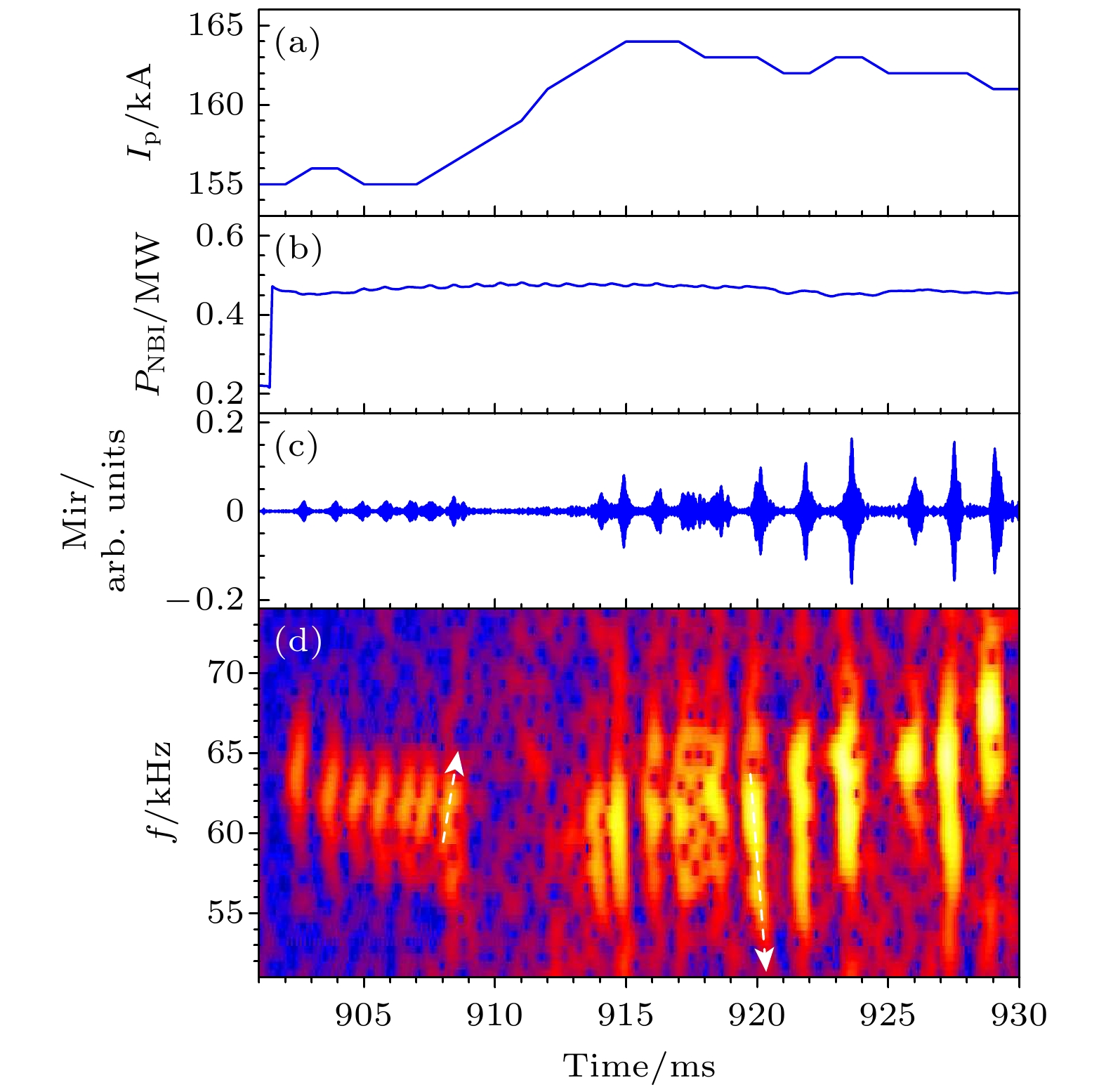
 下载:
下载:
